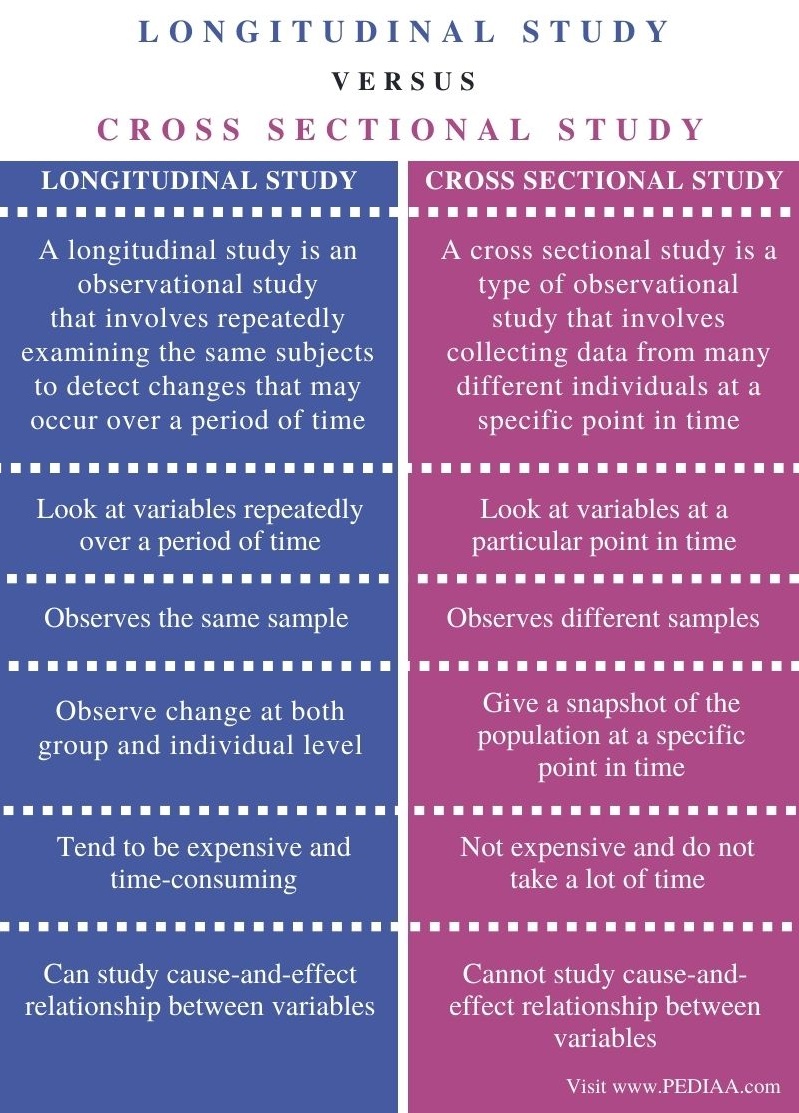Table Of Content

As we’ve demonstrated, a longitudinal study is useful in science, medicine, and many other fields. One of the essential reasons is, longitudinal studies give unique insights that many other types of research fail to provide. One issue related to the use of internet-based survey methods that is likely to be of increasing relevance in the years to come is collection of survey data using a smartphone. As of this writing (this area changes rapidly), smartphone options are in a developing phase where some reasonably good options exist, but have yet to match the flexibility and standardized appearance that comes with most desktop or laptop web-based options just described.
Conduct Longitudinal Surveys that Get Results!
However, it does not mean that a larger number of time points is always better or more accurate than a smaller number of time points. Given that the total time period of study captures the change process of interest, the number of time points should be determined by the appropriate location of the time point. This then brings us to the current practical question on the choice regarding the appropriate length of the interval between adjacent time points. Longitudinal analysis is often conducted to examine how changes happen in the same variable over time. Thus, it is often important to explicitly test measurement invariance before proceeding to model the growth parameters.

Differences in Stability
The nature of the trajectory of change in the substantive variable is descriptively represented by the specific functional form of the trajectory that is observed within the time period of study. We may also include in the latent growth model other substantive variables, such as time-invariant predictors or time-varying correlates, to assess the strength of their associations with variance of the individual slopes of trajectory. These associations serve as validation and explanation of the substantive process of change in the focal variable that is occurring over time. I am not sure these issues of measurement error are “over and above” cross-sectional issues as much as that cross-sectional data provide no mechanisms for dealing with these issues, so they are simply ignored at the analysis stage. In particular, issues of random walk variables (Kuljanin, Braun, & DeShon, 2011) are a potential problem for longitudinal data analysis and the interpretation of either cross-sectional or longitudinal designs.
What is a Longitudinal Study? Definition, Types & Examples
Both groups would then be observed over time to see if there are differences in outcomes, which could suggest an effect of the treatment or intervention. On the other hand, cross-sectional studies tend to be cheaper and quicker but can only provide a snapshot of a point in time and thus cannot identify cause-and-effect relationships. Longitudinal studies tend to require more time and resources, but they can be used to detect cause-and-effect relationships and establish patterns among subjects. For example, familiarity with test items and procedures may allow participants to improve their scores over repeated testing above and beyond any true change. They are constantly shifting, and one survey taken years ago is not going to give you an accurate picture of the shifts in trends.
Participants tend to drop out
A sudden rise (as in a change in slope) in those metrics could be expected based purely on reinforcement theory. Assume, for example, we had six intervals of measurement, and the bonus announcement was made just after the Time 3 data collection. We could specify two slope or change variables and code the first one as 0, 1, 2, 2, 2, and 2, and code the second slope variable as 0, 0, 0, 1, 2, and 3. The latter specification would then independently examine the linear change in each slope variable.
Secure Surveys
For example, if the study was developed strictly following many of the principles for designing quasi-experiments in field settings spelled out by Shadish, Cook, and Campbell (2002), then it would be very useful for developing a theory of change on the phenomenon of interest. Findings from such studies could inform decisions as to how much change needs to occur across time in the independent variable to see measurable change in the dependent variable. Similarly, it would help inform decisions as to what the baseline on the independent variable needs to be, and what amount of change from this baseline is required to impact the dependent variable.
Joint effect of BMI and metabolic status on mortality among adults: a population-based longitudinal study in United ... - Nature.com
Joint effect of BMI and metabolic status on mortality among adults: a population-based longitudinal study in United ....
Posted: Fri, 02 Feb 2024 08:00:00 GMT [source]
Advantages and disadvantages of conducting longitudinal surveys
Qualitative longitudinal research in health research: a method study - BMC Medical Research Methodology - BMC Medical Research Methodology
Qualitative longitudinal research in health research: a method study - BMC Medical Research Methodology.
Posted: Sat, 01 Oct 2022 07:00:00 GMT [source]
By Kendra Cherry, MSEdKendra Cherry, MS, is a psychosocial rehabilitation specialist, psychology educator, and author of the "Everything Psychology Book." Because of this, these studies often have only a small group of subjects, which makes it difficult to apply the results to a larger population. Kendra Cherry, MS, is a psychosocial rehabilitation specialist, psychology educator, and author of the "Everything Psychology Book." There are several actions that could trigger this block including submitting a certain word or phrase, a SQL command or malformed data. Case-control studies compare groups retrospectively and cannot be used to calculate relative risk. Longitudinal studies, though, can compare groups either retrospectively or prospectively.
How to Perform a Longitudinal Study
That said, I do add a restriction to this definition, which is that the time span should be “meaningful.” This term is needed because time will always pass—that is, it takes time to complete questionnaires, do tasks, or observe behavior, even in cross-sectional designs. On the other hand, the measurement interval could last only a few seconds and still be meaningful. To be meaningful it has to support the inferences being made (i.e., improve the research’s validity).
Conversational Forms
One thing that does appear certain, particularly in longitudinal designs, is that incentives are only part of the picture. An additional factor that many researchers have emphasized is the need to maintain contact with participants throughout the duration of a longitudinal survey (Laurie, 2008). Strategies here include obtaining multiple forms of contact information at the outset of the study and continually updating this information. From this information, researchers should make efforts to keep in touch with participants in-between measurement occasions (for panel studies) or some form of ongoing basis (for ESM or other intensive designs). Laurie (2008) referred to these efforts as Keeping In Touch Exercises (KITEs) and suggested that they serve to increase belongingness and perhaps a sense of commitment to the survey effort, and have the additional benefit of obtaining updated contact and other relevant information (e.g., change of job). Aside from the role of memory in determining the content of these reports, individuals also summarize their experiences in a complex manner.
Consider a hypothetical study that repeatedly measured the levels of job performance and social integration of a group of newcomers for six time points, at 1-month intervals between adjacent time points over a 6-month period. Let us assume that the study found that the observed change over time in their job performance levels was best described by a monotonically increasing trajectory at a decreasing rate of change. The observed functional form of the performance trajectory could serve as empirical evidence for the theory that a learning process underlies the performance level changes over time. Let us further assume that, for the same group of newcomers, the observed change over time in their social integration levels was best described by a positive linear trajectory. This observed functional form of the social integration trajectory could serve as empirical evidence for a theory of social adjustment process that underlies the integration level changes over time. In this example, there are two distinct substantive processes of change (learning and social adjustment) that may underlie the changes in levels on the two respective study constructs (performance and social integration).
This happens because comparing groups to estimate retest effects relies on cohort equivalence. It is important to minimize attrition by tracking participants, keeping contact info up to date, engaging them, and providing incentives over time. Missing data can occur during initial sampling if certain groups are underrepresented or fail to respond.
For example, one might be interested in an employee’s immediate affective experiences, task performance, or helping behavior. This approach is particularly common for intensive, short-term longitudinal designs such as experience sampling methods (ESM; Beal & Weiss, 2003). Indeed, the primary objective of ESM is to capture a representative sample of points within one’s day to help understand the dynamic nature of immediate experience (Beal, 2015; Csikszentmihalyi & Larson, 1987).












